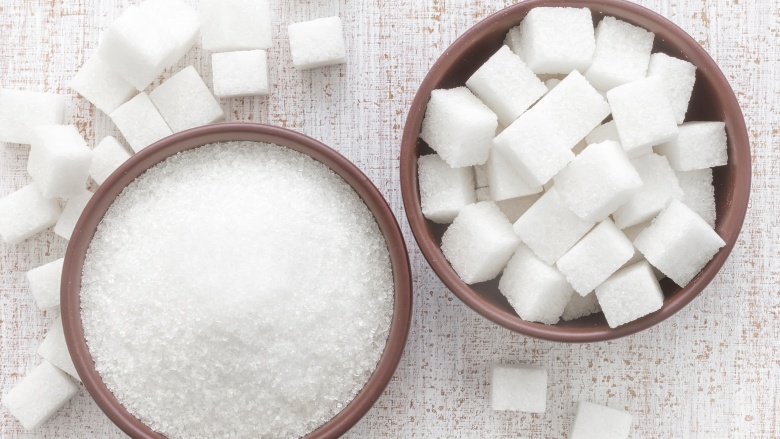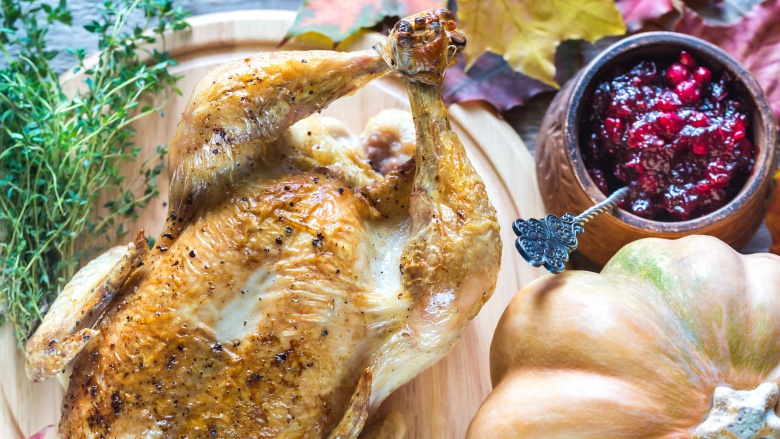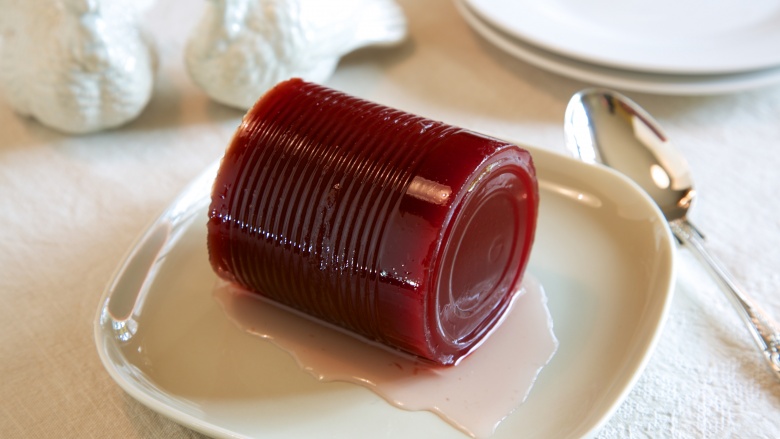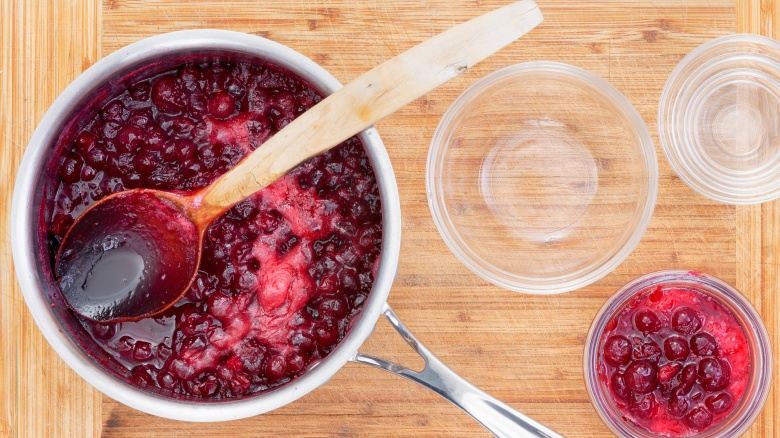What You Need To Know Before You Take Another Bite Of Cranberry Sauce
Cranberry sauce — it inevitably ends up somewhere on the Thanksgiving table. Sometimes it appears in the form of a gelatinous, cylindrical mold removed from a can, sometimes it's a "whole berry" sauce, also removed from a can, and sometimes it's lovingly prepared by a relative's hands. In any case, it's there, begging you to add it to your plate in the name of good health, because, hey, fruit! Surely its produce-derived vitamins and minerals help even out the carb-ilicious mounds of potatoes, stuffing, and gravy you heap next to your turkey. Right?
And yes, cranberries themselves are quite good for you. In fact, a 2010 article published in the Advances in Nutrition review journal points out, "The profile of cranberry bioactives is distinct from that of other berry fruit, being rich in A-type proanthocyanidins (PACs). ... Berry fruit, including cranberries, represent a rich source of phenolic bioactives that may contribute to human health." The article goes on to point out the positive benefits cranberries appear to have on the urinary tract and cardiovascular systems. But before you take another bite of the gooey, red Thanksgiving side dish and think you're bolstering your health, here's what you need to know about that tangy-sweet sauce.
It's loaded with sugar
Cranberries in their natural form are ridiculously tart — not all that different from lemons, actually — which means to make them palatable, cranberries are usually consumed in highly processed, sugar-sweetened forms like juice and cranberry sauce. While you may have some control over how much sugar is added to homemade cranberry sauces, if you're eating the store-bought kind, you're basically eating straight sugar. Take, for instance, the popular Ocean Spray whole berry cranberry sauce. A single, quarter-cup serving is loaded with 22 grams of sugar, while the jellied version boasts 24 grams of sugar. To put it another way, that's the equivalent of about 6 teaspoons of sugar in a single serving.
It has more calories than you might think
Yeah, yeah, yeah, the holidays may not be a time to obsess over calorie intake, but as an exercise physiologist with a master's degree in exercise science, I've learned a few things about nutrition over the years. Namely, calories add up. And unless you're really in love with the calories you're consuming, they may not be worth the extra work and effort you'll have to put in on the other side when those calories come to call. Now, don't get me wrong, cranberry sauce certainly won't be the worst calorie offender on your Thanksgiving Day spread, but because of all the added sugars, a quarter cup of cranberry sauce delivers about 110 calories. Now, if you can't live without the flavor combination of turkey and cranberries, then by all means, enjoy your serving. But if you're dolloping sauce onto your plate out of a weird sense of holiday obligation rather than genuine pleasure, maybe you'd be better off "saving" those extra calories for a piece of pie or an extra serving of stuffing.
The canned version is mostly devoid of nutrients
Processed foods are processed foods, and most of them, whether you're thinking about eating a doughnut or a serving of cranberry sauce, lack significant nutritional value. Now, maybe you're thinking, "Hold up a minute! Cranberries have vitamins and minerals. They have fiber. They help prevent urinary tract infections!" And you'd be right. Cranberries do, in fact, come packed with good-for-you nutrients. But that's when we're talking about cranberries in their natural form, not cranberries that have been cooked down, sugared up, and packaged into cans to make holiday preparation easier. If you look at the nutritional content on those cans of Ocean Spray cranberry sauce again, you'll see a big fat zero listed next to every single vitamin and nutrient included on the label. Except fiber. A single, quarter-cup serving does, in fact, feature one lonely gram of fiber. But then again, a serving of a typical pumpkin pie offers almost 4 grams of fiber, 7 grams protein, and a modest amount of calcium and potassium. And it has less total sugar, too. Granted, pumpkin pie has more fat and total calories, but if you're trying to choose between cranberry sauce or pumpkin pie, pumpkin pie is more nutritionally sound.
You're better off making (and eating) your own
It's hard to deny that cranberry sauce adds nostalgic value to a Thanksgiving feast. Plus, according to UCLA's Science and Food blog, the tannins in cranberry skins readily bind to proteins and fats, making them the perfect turkey pairing (which is why post-Thanksgiving turkey and cranberry sauce sandwiches are so stinkin' delicious). But canned sauces are hard to support when you consider their lack of nutrients and high sugar content. That's why homemade sauces are your better option. They're actually not that hard to make, and the berries retain more of their nutritional content, including higher fiber content (about 5 grams per cup of fresh cranberries), as well as their vitamin C and E content. You also have control of how much sugar to use when making homemade sauce, so if you don't mind a tart dish, you can limit how much sugar you add and even opt for natural forms of sugar, such as raw honey. Try this recipe from Culinary Hill that combines cranberries and Granny Smith apples. Start with half the prescribed sugar (or sub in raw honey), and slowly add more until the flavor is to your liking.
At the end of the day, if you like cranberry sauce, go ahead and enjoy! The Thanksgiving holiday comes just once a year, so there's no harm in a little indulgence. Just don't kid yourself about that canned sauce. It may taste delicious, but it certainly doesn't count as a nutritious serving of fruit.




